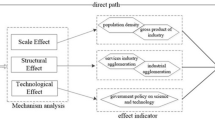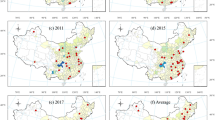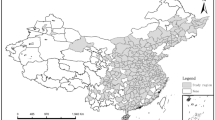Abstract
Based on panel data of 285 prefecture-level and above cities in China from 2003 to 2020, this study has explored the impacts of smart city policy (SCP) on environmental pollution by utilizing the difference-in-differences (DID) model and its derived models. The results indicate that SCP can significantly reduce environmental pollution, and this conclusion still holds after passing numerous robustness tests, such as the propensity-score-matching difference-in-differences (PSM-DID) test, the placebo test, all independent variables lagging one period test, the policy interference test, and the instrument variable (IV) test. Moreover, the heterogeneity analysis shows that the effect of reducing environmental pollution of SCP is heterogeneous. Furthermore, the results of the spatial difference-in-differences (SDID) model show that SCP has a “beggar-thy-neighbor” effect among the pilot cities, and there is no spillover effect of SCP on pollution reduction in neighboring non-pilot cities. Finally, the analysis of moderating effect reflects that the government intervention plays a negative inhibition role in the process of SCP affecting environmental pollution, while the market competition plays a positive catalytic role in the process of SCP reducing environmental pollution.




Similar content being viewed by others
Data availability
The data used to support the findings of this study are available from the corresponding author upon request.
References
Bao Z, Zhou X, Li G (2022) Does the Internet Promote Green Total Factor Productivity? Empirical Evidence from China. Pol J Environ Stud 31:1037–1048. https://doi.org/10.15244/pjoes/141806
Bertrand M, Duflo E, Mullainathan S (2004) How much should we trust differences-in-differences estimates? Quart J Econ 119:249–275. https://doi.org/10.1162/003355304772839588
Caragliu A, Del Bo CF (2018) The economics of smart city policies. Scienze Regionali 17:81–104. https://doi.org/10.14650/88818
Caragliu A, Del Bo C, Nijkamp P (2011) Smart cities in Europe. J Urban Technol 18:65–82. https://doi.org/10.1080/10630732.2011.601117
Chagas ALS, Azzoni CR, Almeida AN (2016) A spatial difference-in-differences analysis of the impact of sugarcane production on respiratory diseases. Reg Sci Urban Econ 59:24–36. https://doi.org/10.1016/j.regsciurbeco.2016.04.002
Chen L, Li K, Chen S, Wang X, Tang L (2021a) Industrial activity, energy structure, and environmental pollution in China. Energy Econ 104:105633. https://doi.org/10.1016/j.eneco.2021.105633
Chen Y, Lee C-C (2020) Does technological innovation reduce CO2 emissions? Cross-country evidence. J Clean Prod 263. https://doi.org/10.1016/j.jclepro.2020.121550
Chen L, Yu Y (2021) How does environmental pollution erode political trust in China? A multilevel analysis. Environ Impact Assess Rev 88. https://doi.org/10.1016/j.eiar.2021.106553
Chen Y, Cheng L, Lee C-C, Wang-S (2021b) The impact of regional banks on environmental pollution: evidence from China’s city commercial banks. Energy Econ 102. https://doi.org/10.1016/j.eneco.2021.105492
Chu Z, Cheng M, Yu NN (2021) A smart city is a less polluted city. Technol Forecast Soc Change 172. https://doi.org/10.1016/j.techfore.2021.121037
Cui N, Hao H, Wang G, Wang W, Wang Y (2008) Orthogonal design-directed optimization of an LC method for fingerprinting Mai-Luo-Ning injection, and validation of the method. Chromatographia 68:33–39. https://doi.org/10.1365/s10337-008-0650-2
Deng Z, Liu Y, Zhu Z, Luo D, Gu C, Zhou L, Xie G, Li W (2021) Ultra-precise optical phase-locking approach for ultralow noise frequency comb generation”. Optics Laser Technol 138:106906. https://doi.org/10.1016/j.optlastec.2020.106906
Duranton G, Turner MA (2012) Urban growth and transportation. Rev Econ Stud 79:1407–1440. https://doi.org/10.1093/restud/rds010
Duygan M, Fischer M, Pärli R, Ingold K (2022) Where do Smart Cities grow? The spatial and socio-economic configurations of smart city development. Sustain Cities Soc 77. https://doi.org/10.1016/j.scs.2021.103578
Fan Q, Qiao Y, Zhang T, Huang K (2021) Environmental regulation policy, corporate pollution control and economic growth effect: evidence from China. Environ Challenges 5. https://doi.org/10.1016/j.envc.2021.100244
Feng Y, Hu S (2022) The effect of smart city policy on urban haze pollution in China: empirical evidence from a quasi-natural experiment. Pol J Environ Stud 31:2083–2092. https://doi.org/10.15244/pjoes/143775
Gao K, Yuan Y (2022) Is the sky of smart city bluer? Evidence from satellite monitoring data. J Environ Manag 317:115483. https://doi.org/10.1016/j.jenvman.2022.115483
Guo K, Cao Y, Wang Z, Li Z (2022a) Urban and industrial environmental pollution control in China: an analysis of capital input, efficiency and influencing factors. J Environ Manag 316:115198. https://doi.org/10.1016/j.jenvman.2022.115198
Guo W, Yexi Z, Xinghua F, Jianxin L (2019) County-level highway network centrality of urban agglomerations and its influencing factors in the middle reaches of the Yangtze River
Guo Q, Wang Y, Dong X (2022b) Effects of smart city construction on energy saving and CO2 emission reduction: Evidence from China. Appl Energy 313. https://doi.org/10.1016/j.apenergy.2022.118879
Haarstad H, Wathne MW (2019) Are smart city projects catalyzing urban energy sustainability? Energy Policy 129:918–925. https://doi.org/10.1016/j.enpol.2019.03.001
Hao Y, Ling-Ou W, Chien-Chiang L (2020) Financial development, energy consumption and China’s economic growth: new evidence from provincial panel data. Int Rev Econ Financ 69:1132–1151. https://doi.org/10.1016/j.iref.2018.12.006
Huang J, Pan X, Guo X, Li G (2018) Health impact of China’s Air Pollution Prevention and Control Action Plan: an analysis of national air quality monitoring and mortality data. Lancet Planet Health 2:e313–e323. https://doi.org/10.1016/s2542-5196(18)30141-4
Huovila A, Bosch P, Airaksinen M (2019) Comparative analysis of standardized indicators for Smart sustainable cities: what indicators and standards to use and when? Cities 89:141–153. https://doi.org/10.1016/j.cities.2019.01.029
Jiang L, Lin C, Lin P (2014) The determinants of pollution levels: Firm-level evidence from Chinese manufacturing. J Comp Econ 42:118–142. https://doi.org/10.1016/j.jce.2013.07.007
Jiang L, He S, Zhou H, Kong H, Wang J, Cui Y, Wang L (2021b) Coordination between sulfur dioxide pollution control and rapid economic growth in China: evidence from satellite observations and spatial econometric models. Struct Chang Econ Dyn 57:279–291. https://doi.org/10.1016/j.strueco.2021.04.001
Jiang H, Jiang P, Wang D, Wu J (2021a) Can smart city construction facilitate green total factor productivity? A quasi-natural experiment based on China’s pilot smart city. Sustaina Cities Soc 69. https://doi.org/10.1016/j.scs.2021.102809
Jo H, Kim H-E, Sim M (2022) Environmental preference, air pollution, and fund flows in China. Pacif-Basin Financ J 72. https://doi.org/10.1016/j.pacfin.2022.101723
Kendy E, Zhang Y, Liu C, Wang J, Steenhuis T (2004) Groundwater recharge from irrigated cropland in the North China Plain: case study of Luancheng County, Hebei Province, 1949–2000. Hydrol Process 18:2289–2302. https://doi.org/10.1002/hyp.5529
Kirimtat A, Krejcar O, Tasgetiren MF, Herrera-Viedma E (2021) Multi-performance based computational model for the cuboid open traveling salesman problem in a smart floating city. Build Environ 196. https://doi.org/10.1016/j.buildenv.2021.107721
Kunrong S, Gang J (2020) The Policy effects of the environmental governance of Chinese local governments: a study based on the progress of the river chief system. Social Sci China 41:87–105. https://doi.org/10.1080/02529203.2020.1806475
Li JS (2003) Relation-based versus rule-based governance: an explanation of the East Asian miracle and Asian crisis. Rev Int Econ 11(4):651–673. https://doi.org/10.1111/1467-9396.00409
Li X, Fong PSW, Dai S, Li Y (2019) Towards sustainable smart cities: an empirical comparative assessment and development pattern optimization in China. J Clean Prod 215:730–743. https://doi.org/10.1016/j.jclepro.2019.01.046
Li L, Zheng Y, Zheng S, Ke H (2020) The new smart city programme: evaluating the effect of the internet of energy on air quality in China. Sci Total Environ 714:136380. https://doi.org/10.1016/j.scitotenv.2019.136380
Liao L, Du M, Chen Z (2021) Air pollution, health care use and medical costs: evidence from China. Energy Econ 95. https://doi.org/10.1016/j.eneco.2021.105132
Lin B, Liu H (2015) China’s building energy efficiency and urbanization. Energy Build 86:356–365. https://doi.org/10.1016/j.enbuild.2014.09.069
Lin B, Xu C (2022) Does environmental decentralization aggravate pollution emissions? Microscopic evidence from Chinese industrial enterprises. Sci Total Environ 829:154640. https://doi.org/10.1016/j.scitotenv.2022.154640
Lin B, Zhou Y (2022) Understanding the institutional logic of urban environmental pollution in China: evidence from fiscal autonomy. Process Saf Environ Prot 164:57–66. https://doi.org/10.1016/j.psep.2022.06.005
Liu P, Peng Z (2014) China’s smart city pilots: a progress report. Computer 47:72–81. https://doi.org/10.1109/MC.2013.149
Liu F, Zhang Y, Li H, Zhang C, Deng W, Shi Y (2019) Meta-analysis of peer effects on smart cities. Procedia Comput Sci 162:873–877. https://doi.org/10.1016/j.procs.2019.12.062
Liu S, Liu C, Yang M (2021) The effects of national environmental information disclosure program on the upgradation of regional industrial structure: Evidence from 286 prefecture-level cities in China. Struct Chang Econ Dyn 58:552–561. https://doi.org/10.1016/j.strueco.2021.07.006
Liu H, Liu H, Cheng Y (2022a) Illustrating the multi-stakeholder perceptions of environmental pollution based on big data: lessons from China. Reg Sustain 3:12–26. https://doi.org/10.1016/j.regsus.2022.03.003
Liu X, Zhong S, Li S, Yang M (2022b) Evaluating the impact of central environmental protection inspection on air pollution: an empirical research in China. Process Saf Environ Prot 160:563–572. https://doi.org/10.1016/j.psep.2022.02.048
Lu W, Wu H, Geng S (2021) Heterogeneity and threshold effects of environmental regulation on health expenditure: considering the mediating role of environmental pollution. J Environ Manag 297:113276. https://doi.org/10.1016/j.jenvman.2021.113276
Meijer A, Thaens M (2018) Urban technological innovation: developing and testing a sociotechnical framework for studying smart city projects. Urban Affairs Rev 54:363–387. https://doi.org/10.1177/1078087416670274
Papastamatiou I, Marinakis V, Doukas H, Psarras J (2017) A decision support framework for smart cities energy assessment and optimization. Energy Procedia 111:800–809. https://doi.org/10.1016/j.egypro.2017.03.242
Shelton T, Zook M, Wiig A (2015) The ‘actually existing smart city.’ Camb J Reg Econ Soc 8:13–25. https://doi.org/10.1093/cjres/rsu026
Shen L, Huang Z, Wong Siu W, Liao S, Lou Y (2018) A holistic evaluation of smart city performance in the context of China. J Clean Prod 200:667–679. https://doi.org/10.1016/j.jclepro.2018.07.281
Song M, Tan KH, Wang J, Shen Z (2022) Modeling and evaluating economic and ecological operation efficiency of smart city pilots. Cities 124. https://doi.org/10.1016/j.cities.2022.103575
Wang J, Deng K (2022) Impact and mechanism analysis of smart city policy on urban innovation: evidence from China. Econ Anal Policy 73:574–587. https://doi.org/10.1016/j.eap.2021.12.006
Wang Q, Tang J, Choi G (2021) A two-stage eco-efficiency evaluation of China’s industrial sectors: a dynamic network data envelopment analysis (DNDEA) approach. Process Saf Environ Prot 148:879–892. https://doi.org/10.1016/j.psep.2021.02.005
Wang Y, Duan X, Wang L, Zou H (2022b) Spatial temporal patterns and driving factors of industrial pollution and structures in the Yangtze River Economic Belt. Chemosphere 303:134996. https://doi.org/10.1016/j.chemosphere.2022.134996
Wang K-L, Pang S-Q, Zhang F-Q, Miao Z, Sun H-P (2022a) The impact assessment of smart city policy on urban green total-factor productivity: evidence from China. Environ Impact Assess Rev 94. https://doi.org/10.1016/j.eiar.2022.106756
Wu H, Xia Y, Yang X, Yu H, Ren S (2021) Does environmental pollution promote China’s crime rate? A new perspective through government official corruption. Struct Chang Econ Dyn 57:292–307. https://doi.org/10.1016/j.strueco.2021.04.006
Xi Q, Mei L (2022) How did development zones affect China’s land transfers? The scale, marketization, and resource allocation effect. Land Use Policy 119:106181. https://doi.org/10.1016/j.landusepol.2022.106181
Yao T, Huang Z, Zhao W (2020) Are smart cities more ecologically efficient? Evidence from China. Sustain Cities Soc 60. https://doi.org/10.1016/j.scs.2019.102008
Yigitcanlar T, Kamruzzaman Md (2018) Does smart city policy lead to sustainability of cities? Land Use Policy 73:49–58. https://doi.org/10.1016/j.landusepol.2018.01.034
Yu Y, Zhang N (2019) Does smart city policy improve energy efficiency? Evidence from a quasi-natural experiment in China. J Clean Prod 229:501–512. https://doi.org/10.1016/j.jclepro.2019.04.316
Yuan F, Zhai Y, Sun X, Dong Y (2022) Air pollution mitigation: Evidence from China’s central environmental inspection. Environ Impact Assess Rev 96. https://doi.org/10.1016/j.eiar.2022.106835
Yuen B (2018) Singapore: smart city, smart state. J Southeast Asian Stud 49:349–351. https://doi.org/10.1017/s0022463418000152
Zhang X, Fan D (2023) Collaborative emission reduction research on dual-pilot policies of the low-carbon city and smart city from the perspective of multiple innovations”. Urban Climate 47:101364. https://doi.org/10.1016/j.uclim.2022.101364
Zhang L, Huang S (2022) Social capital and regional innovation efficiency: the moderating effect of governance quality. Struct Chang Econ Dyn 62:343–359. https://doi.org/10.1016/j.strueco.2022.05.013
Zhang Xu, Ou X, Yang X, Qi T, Nam K, Zhang D, Zhang X (2017) Socioeconomic burden of air pollution in China: province-level analysis based on energy economic model. Energy Econ 68:478–489. https://doi.org/10.1016/j.eneco.2017.10.013
Zhang W, Li G, Guo F (2022) Does carbon emissions trading promote green technology innovation in China? Appl Energy 315:119012. https://doi.org/10.1016/j.apenergy.2022.119012
Zhang Z, Zhang J, Feng Y (2021) Assessment of the carbon emission reduction effect of the air pollution prevention and control action plan in China. Int J Environ Res Public Health 18. https://doi.org/10.3390/ijerph182413307
Zhang H, Xu T, Feng C (2022a) Does public participation promote environmental efficiency? Evidence from a quasi-natural experiment of environmental information disclosure in China. Energy Econ
Zhao Z, Zhang Y (2020) Impact of smart city planning and construction on economic and social benefits based on big data analysis. Complexity 2020:8879132. https://doi.org/10.1155/2020/8879132
Funding
This research was supported by the National Social Science Foundation of China (No. 20BJY094 & 2020FYB010), and the Postdoctoral Research Foundation of China (No. 2022M720131), the Program for Science&Technology Innovation Talents in Universities of Henan Province (Grant No. 2021-CX-018), and the Great Education Science Bidding Project of 14th Five Year Plan in 2022 of Henan Province (Grant No. 2021JKZB05).
Author information
Authors and Affiliations
Contributions
Conceptualization, S.Q. and Y.F.; methodology, R.W.; software, R.W.; validation, S.Q. and R.W.; formal analysis, Y.F.; data curation, Y.P. and Y.F.; writing—original draft preparation, R.W.; writing—review and editing, Y.P. and Y.F.; visualization, Y.P. and Y.F.; supervision, S.Q. and Y.F.; funding acquisition, S.Q. All authors have read and agreed to the published version of the manuscript.
Corresponding author
Ethics declarations
Ethics approval and consent to participate.
Not applicable.
Consent for publication
Not applicable.
Conflict of interest
The authors declare no competing interests.
Additional information
Responsible Editor: Philippe Garrigues
Publisher's note
Springer Nature remains neutral with regard to jurisdictional claims in published maps and institutional affiliations.
Rights and permissions
Springer Nature or its licensor (e.g. a society or other partner) holds exclusive rights to this article under a publishing agreement with the author(s) or other rightsholder(s); author self-archiving of the accepted manuscript version of this article is solely governed by the terms of such publishing agreement and applicable law.
About this article
Cite this article
Shen, Q., Wu, R., Pan, Y. et al. The effectiveness of smart city policy on pollution reduction in China: new evidence from a quasi-natural experiment. Environ Sci Pollut Res 30, 52841–52857 (2023). https://doi.org/10.1007/s11356-023-26010-8
Received:
Accepted:
Published:
Issue Date:
DOI: https://doi.org/10.1007/s11356-023-26010-8




